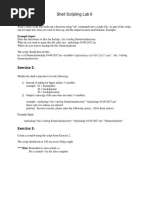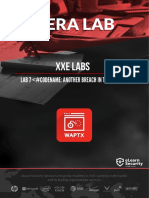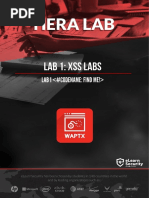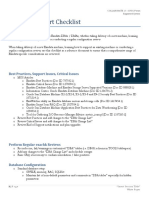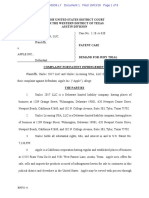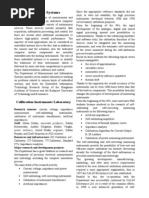Lab10 - Dirbuster
Lab10 - Dirbuster
Uploaded by
Saw GyiCopyright:
Available Formats
Lab10 - Dirbuster
Lab10 - Dirbuster
Uploaded by
Saw GyiOriginal Description:
Copyright
Available Formats
Share this document
Did you find this document useful?
Is this content inappropriate?
Copyright:
Available Formats
Lab10 - Dirbuster
Lab10 - Dirbuster
Uploaded by
Saw GyiCopyright:
Available Formats
© 2019 Caendra Inc.
| Hera for PTSv4 | Dirbuster 1
You are a Penetration Tester hired by the company AwdMgmt to perform security tests on
their internal Web Application and machines. You are asked to perform the penetration
test on the client premises. During this engagement you are not given a well-defined scope.
You are sitting in the client corporate building, directly attached to the client network.
The goal of this lab is to first find the web servers in the network you are directly attached.
Then to test the Web Application running on it in order to check if you can access restricted
areas (such as the login page)!
The best tools for this lab are:
• Dirbuster
• mysql
• Web browser
© 2019 Caendra Inc. | Hera for PTSv4 | Dirbuster 2
Since we do not have any information about the network and related hosts, the first step is
to find all alive hosts in the network.
Now that we know there is a host on the target network, let us scan it and gather as much
information as we can about it. We are interested in web servers.
Once we have found a web server explore the Web Application from a web browser and
analyze it.
Remember that the goal of our tests is to access the restricted web area.
Now that you have an idea of how the Web Application works, run dirbuster and check if
there is any file that may be useful to access the login page!
You should have found two interesting files. Use the information stored in these two file to
access the DMBS.
© 2019 Caendra Inc. | Hera for PTSv4 | Dirbuster 3
Now that you have access to the database, dump the administrator credentials and try to
log into the Web Application.
© 2019 Caendra Inc. | Hera for PTSv4 | Dirbuster 4
Please go ahead ONLY if you have COMPLETED the lab or you are stuck! Checking the
solutions before actually trying the concepts and techniques you studied in the course, will
dramatically reduce the benefits of a hands-on lab!
© 2019 Caendra Inc. | Hera for PTSv4 | Dirbuster 5
[This page intentionally left blank]
© 2019 Caendra Inc. | Hera for PTSv4 | Dirbuster 6
We first need to find the address of the corporate network we are connected to. We can do
so by running ifconfig and check the IP address of our tap0 interface.
As we can see the target network is 10.104.11.0/24. Let's run nmap -sn in order to
discover all the available hosts on the network:
The previous screenshot shows that there are two hosts alive in the network: 10.104.11.96
and 10.104.11.198.
© 2019 Caendra Inc. | Hera for PTSv4 | Dirbuster 7
Let us run nmap in order to gather information about the services listening on our targets.
To do this we will run a -sV scan as follow:
From the results, we can see that the machine with IP address 10.104.11.96 is running
Apache on port 80, meaning that it is probably hosting the internal web application, while
the other machine (10.104.11.198) is running MySQL.
Since the scope of the engagement is to check if an attacker can access restricted areas of
the web application, let’s focus our tests on the machine 10.104.11.96.
© 2019 Caendra Inc. | Hera for PTSv4 | Dirbuster 8
In order to inspect the web application we just need to type the IP address of the target
machine into our browser.
If we inspect the web application, we can see that the "Sign up" page is not available,
meaning that we cannot create a new user in order to access the restricted area.
Moreover, we do not have any valid credential to use and the form seems not vulnerable to
any SQL injection attack.
© 2019 Caendra Inc. | Hera for PTSv4 | Dirbuster 9
Since we do not want to bruteforce the login form, we can try to run discovery tools such as
dirbuster in order to find hidden files that may help us with our goal.
Let us start dirbuster and run a scan using the directory-list-2.3.-small.txt file. After a
minute or two, we should start getting some interesting results:
© 2019 Caendra Inc. | Hera for PTSv4 | Dirbuster 10
Here we can see that in the include folder there is a file named config.old. Let us inspect it
and see if there is anything interesting in it:
© 2019 Caendra Inc. | Hera for PTSv4 | Dirbuster 11
As we can see, the file contains some database credentials! If you recall, in the previous
steps we had found a machine running MySQL. Let us try a DB connection to this machine
with the credentials just found:
© 2019 Caendra Inc. | Hera for PTSv4 | Dirbuster 12
Unfortunately, it seems that the credentials are not working. Let us keep investigating the
files found with dirbuster. If we check the previous screenshot, we can see that there is a
page named signup.php that we were not able to access from the links in the web
application:
This is even better of the previous file found.
© 2019 Caendra Inc. | Hera for PTSv4 | Dirbuster 13
Let us try the credentials found in the signup.php file and see if we are able to access the
DB!
As we can see, this time we are successfully logged into the database! Let us inspect it!
© 2019 Caendra Inc. | Hera for PTSv4 | Dirbuster 14
Let us use some simple mysql commands to navigate the database and check if there is
anything interesting in it. First, we will have to select the database to use and then inspect
its tables and data:
With the information just obtained, let us try to log into the web application:
We are logged in!!
© 2019 Caendra Inc. | Hera for PTSv4 | Dirbuster 15
You might also like
- Integrative Programming and Technologies Chapter-1Document14 pagesIntegrative Programming and Technologies Chapter-1nigussie76% (21)
- CHFI v3 Module 01 Computer Forensics in Todays WorldDocument41 pagesCHFI v3 Module 01 Computer Forensics in Todays WorldIsrael GonzalezNo ratings yet
- CPENTbrochureDocument9 pagesCPENTbrochuremy lover IamNo ratings yet
- TR18 AD MSFT Defence at ScaleDocument31 pagesTR18 AD MSFT Defence at ScalekeepzthebeezNo ratings yet
- The Threat Environment: Attackers and Their AttacksDocument8 pagesThe Threat Environment: Attackers and Their AttacksbseosNo ratings yet
- Endp Pre ExamDocument4 pagesEndp Pre ExamSaw GyiNo ratings yet
- © 2018 Caendra, Inc. - Hera For PTP - SNMP AnalysisDocument13 pages© 2018 Caendra, Inc. - Hera For PTP - SNMP AnalysisSaw GyiNo ratings yet
- Cyber Security MumbaiDocument18 pagesCyber Security Mumbairony raiNo ratings yet
- Lab 6 Shell ScriptingDocument1 pageLab 6 Shell ScriptingSiva KrishnaNo ratings yet
- Gcia ToolsDocument17 pagesGcia Toolsjbrackett239No ratings yet
- ForensicsDocument3 pagesForensicsJosiah MarcanoNo ratings yet
- Top Burp Suite Extension Used by PentestersDocument27 pagesTop Burp Suite Extension Used by Pentestersitssconsultores100% (1)
- Forensic Analysis of Ransomware Infected Windows Hard Disk A Case StudyDocument4 pagesForensic Analysis of Ransomware Infected Windows Hard Disk A Case StudyInternational Journal of Innovative Science and Research TechnologyNo ratings yet
- Lab Experiment #08 - Network & Host Detection ScansDocument3 pagesLab Experiment #08 - Network & Host Detection ScansAnoop DasNo ratings yet
- 27.2.15 Lab - Investigating A Malware Exploit - ILMDocument17 pages27.2.15 Lab - Investigating A Malware Exploit - ILMKamel Ziani100% (1)
- Use of Metasploit Framework in Kali Linux: April 2015Document9 pagesUse of Metasploit Framework in Kali Linux: April 2015proftechitspecialist100% (1)
- CHFI v10 Course ContentDocument8 pagesCHFI v10 Course ContentAbhijith UpNo ratings yet
- CHFI v3 Module 04 First Responder ProceduresDocument75 pagesCHFI v3 Module 04 First Responder ProceduresIsrael GonzalezNo ratings yet
- Comprehensive LabDocument32 pagesComprehensive LabSudharsan Bala100% (1)
- Material de Estudiante CEHPC (V0220224) enDocument123 pagesMaterial de Estudiante CEHPC (V0220224) enCristóbal HerreraNo ratings yet
- How-To: DNS Enumeration: Author: Mohd Izhar AliDocument13 pagesHow-To: DNS Enumeration: Author: Mohd Izhar Alidmbowie89No ratings yet
- Malware AnalysisDocument5 pagesMalware AnalysisRavi KumarNo ratings yet
- Tryhackme: Overpass 2 - Hacked Walkthrough: 1. What Was The Url of The Page They Used To Upload A Reverse Shell?Document11 pagesTryhackme: Overpass 2 - Hacked Walkthrough: 1. What Was The Url of The Page They Used To Upload A Reverse Shell?SECURITY 365No ratings yet
- Detection of Phishing Attacks Nakul AryaDocument10 pagesDetection of Phishing Attacks Nakul AryaAk MishraNo ratings yet
- WIRESHARK SheetDocument16 pagesWIRESHARK SheetJustyn Sanchez RuizNo ratings yet
- DNSReconDocument15 pagesDNSReconEmmanuel Shivina KhisaNo ratings yet
- CHFI v3 Module 12 Data Acquisition and DuplicationDocument44 pagesCHFI v3 Module 12 Data Acquisition and DuplicationIsrael GonzalezNo ratings yet
- CH 6Document38 pagesCH 6Ain AnuarNo ratings yet
- Page - 1: WWW - Hackingarticles.inDocument29 pagesPage - 1: WWW - Hackingarticles.inEst Ortiz RoNo ratings yet
- LAB - Creating RulesDocument31 pagesLAB - Creating RulesRAMDIA SECURITYNo ratings yet
- Spotting The Adversary With Windows Event Log MonitoringDocument54 pagesSpotting The Adversary With Windows Event Log Monitoringquedyah100% (1)
- 9.3.8 Lab - Exploring NmapDocument7 pages9.3.8 Lab - Exploring Nmapbui lamNo ratings yet
- 15 - CHFI (Mobile and IoT Forensics) - RDDocument46 pages15 - CHFI (Mobile and IoT Forensics) - RDSHANDY SK -X MIPA3No ratings yet
- 310 Red Teaming MS SQL Server PDFDocument139 pages310 Red Teaming MS SQL Server PDFJane mwangiNo ratings yet
- Lab 8 - Gaining Access of Metasploitable Machine Using Metasploit FrameworkDocument1 pageLab 8 - Gaining Access of Metasploitable Machine Using Metasploit FrameworkPratham PandeyNo ratings yet
- With Emphasis On Web Applications Security Related IssuesDocument28 pagesWith Emphasis On Web Applications Security Related IssuesFsohail0% (1)
- 3.2.11 Lab - Exploring Processes, Threads, Handles, and Windows RegistryDocument4 pages3.2.11 Lab - Exploring Processes, Threads, Handles, and Windows Registrytinod18399No ratings yet
- Lecture - 5 31 Jan 2018 IDS IPS Honeypot PDFDocument101 pagesLecture - 5 31 Jan 2018 IDS IPS Honeypot PDFpadmaNo ratings yet
- Webscarab InstructionsDocument12 pagesWebscarab InstructionsLin DengNo ratings yet
- Module 1 Network Security IntroductionDocument26 pagesModule 1 Network Security IntroductionHans de BritoNo ratings yet
- Attacked From Behind Application PDFDocument24 pagesAttacked From Behind Application PDFDavid F MartinezNo ratings yet
- Advanced Cross Site Scripting: and CSRFDocument42 pagesAdvanced Cross Site Scripting: and CSRFbomejeb102No ratings yet
- 07-Flash SecurityDocument3 pages07-Flash SecuritySaw GyiNo ratings yet
- ShodanDocument1 pageShodancarlos olivaNo ratings yet
- CISCO Secure Intrusion Detection SystemDocument45 pagesCISCO Secure Intrusion Detection SystemFahmi Shah100% (1)
- How To Implement SSL Decryption PDFDocument11 pagesHow To Implement SSL Decryption PDFvijoynew5233No ratings yet
- Enumeration and Foot PrintingDocument19 pagesEnumeration and Foot Printingxeyog51371No ratings yet
- Building Maturing and Rocking A Security Operations Center Brandie AndersonDocument19 pagesBuilding Maturing and Rocking A Security Operations Center Brandie AndersonellococarelocoNo ratings yet
- Module 06 - Intrusion Detection SystemDocument53 pagesModule 06 - Intrusion Detection SystemFaizul Ghazi100% (1)
- CCNA Sec 01Document11 pagesCCNA Sec 01Aissa ChaabiNo ratings yet
- Lab Assignment Module 3 Lab 2Document7 pagesLab Assignment Module 3 Lab 2Jonathan PenaNo ratings yet
- Virtual Private NetworkDocument10 pagesVirtual Private NetworkHrishikesh JagdhaneNo ratings yet
- How To Install Parrot OS in VirtualBox On Windows PCsDocument12 pagesHow To Install Parrot OS in VirtualBox On Windows PCsRanjan RajbanshiNo ratings yet
- Udemy Dump 2Document111 pagesUdemy Dump 2Gani RKNo ratings yet
- Penetration Testing CommandsDocument22 pagesPenetration Testing CommandsPhani Mohan KopalleNo ratings yet
- Learning Objectives of Memory Analysis: SEPTEMBER 27, 2020Document14 pagesLearning Objectives of Memory Analysis: SEPTEMBER 27, 2020simasiku.oliver99No ratings yet
- Network Monitoring Using AlienVaultDocument15 pagesNetwork Monitoring Using AlienVaultFathimah RahimullahNo ratings yet
- CS - Practical ReportDocument44 pagesCS - Practical ReportLatashree HegdeNo ratings yet
- Manual NiktoDocument47 pagesManual NiktoMade Urip SumaharjaNo ratings yet
- Itec413 15Document33 pagesItec413 15Burak Ulucinar100% (1)
- © 2019 Caendra, Inc. - Hera For Waptv3 - Exploiting WordpressDocument38 pages© 2019 Caendra, Inc. - Hera For Waptv3 - Exploiting WordpressSaw GyiNo ratings yet
- © 2018 Caendra Inc. - Hera For Waptv3 - IntroductionDocument10 pages© 2018 Caendra Inc. - Hera For Waptv3 - IntroductionSaw GyiNo ratings yet
- © 2018 Caendra Inc. - Hera For Waptv3 - Other AttacksDocument6 pages© 2018 Caendra Inc. - Hera For Waptv3 - Other AttacksSaw GyiNo ratings yet
- © 2018 Caendra Inc. - Hera For Waptv3 - File and Resource AttacksDocument6 pages© 2018 Caendra Inc. - Hera For Waptv3 - File and Resource AttacksSaw GyiNo ratings yet
- 06-Session SecurityDocument48 pages06-Session SecuritySaw GyiNo ratings yet
- 07-Flash SecurityDocument3 pages07-Flash SecuritySaw GyiNo ratings yet
- © 2018 Caendra Inc. - Hera For Waptv3 - Cross Site ScriptingDocument33 pages© 2018 Caendra Inc. - Hera For Waptv3 - Cross Site ScriptingSaw GyiNo ratings yet
- © 2018 Caendra Inc. - Hera For Waptv3 - Information GatheringDocument9 pages© 2018 Caendra Inc. - Hera For Waptv3 - Information GatheringSaw GyiNo ratings yet
- © 2018 Caendra Inc. - Hera For Waptv3 - SQL InjectionDocument41 pages© 2018 Caendra Inc. - Hera For Waptv3 - SQL InjectionSaw GyiNo ratings yet
- © 2020 Caendra Inc. - Hera For Waptxv2 - Insecure RmiDocument9 pages© 2020 Caendra Inc. - Hera For Waptxv2 - Insecure RmiSaw GyiNo ratings yet
- © 2019 Caendra Inc. - Hera For Waptxv2 - XML Entity Expansion LabsDocument13 pages© 2019 Caendra Inc. - Hera For Waptxv2 - XML Entity Expansion LabsSaw GyiNo ratings yet
- LM10b XSLT To Code ExecutionDocument10 pagesLM10b XSLT To Code ExecutionSaw GyiNo ratings yet
- © 2020 Caendra Inc. - Hera For Waptxv2 - HTML Adapter To RootDocument10 pages© 2020 Caendra Inc. - Hera For Waptxv2 - HTML Adapter To RootSaw GyiNo ratings yet
- LM9b Java Insecure Deserialization 2Document13 pagesLM9b Java Insecure Deserialization 2Saw GyiNo ratings yet
- © 2020 Caendra Inc. - Hera For Waptxv2 - Attacking LdapDocument9 pages© 2020 Caendra Inc. - Hera For Waptxv2 - Attacking LdapSaw GyiNo ratings yet
- © 2020 Caendra Inc. - Hera For Waptxv2 - CSRF LabsDocument4 pages© 2020 Caendra Inc. - Hera For Waptxv2 - CSRF LabsSaw GyiNo ratings yet
- © 2019 Caendra Inc. - Hera For Waptxv2 - Xxe LabsDocument16 pages© 2019 Caendra Inc. - Hera For Waptxv2 - Xxe LabsSaw GyiNo ratings yet
- © 2020 Caendra Inc. - Hera For Waptxv2 - Xss LabsDocument3 pages© 2020 Caendra Inc. - Hera For Waptxv2 - Xss LabsSaw GyiNo ratings yet
- © 2020 Caendra Inc. - Hera For Waptxv2 - XML Injection LabsDocument10 pages© 2020 Caendra Inc. - Hera For Waptxv2 - XML Injection LabsSaw GyiNo ratings yet
- Hera - PND Lab: User ManualDocument17 pagesHera - PND Lab: User ManualSaw GyiNo ratings yet
- © 2020 Caendra Inc. - Hera For Waptxv2 - Sqli Playground LabsDocument2 pages© 2020 Caendra Inc. - Hera For Waptxv2 - Sqli Playground LabsSaw GyiNo ratings yet
- Master's Degree in Telecommunications Engineering (MET) (ETSETB)Document27 pagesMaster's Degree in Telecommunications Engineering (MET) (ETSETB)ssejjuuko paulNo ratings yet
- Exadata Support ChecklistDocument7 pagesExadata Support Checklistshaikali1980No ratings yet
- MT4 Secure Software 21 CFR Part 11Document5 pagesMT4 Secure Software 21 CFR Part 11Ricardo Fabián Durán ValenciaNo ratings yet
- Introduction To Distributed SystemsDocument14 pagesIntroduction To Distributed SystemszanchoozanchooNo ratings yet
- N+ SyllabusDocument3 pagesN+ SyllabusPotey Desmanois50% (2)
- Arcadis: System Software, Service InformationDocument42 pagesArcadis: System Software, Service Informationllpbio2No ratings yet
- Cloud VR Oriented Bearer Network White Paper en v2Document36 pagesCloud VR Oriented Bearer Network White Paper en v2Francisco de AssisNo ratings yet
- Uniloc AirDrop Patent SuitDocument17 pagesUniloc AirDrop Patent SuitMikey CampbellNo ratings yet
- DullGelinasWheeler9e TB Chapter 03Document18 pagesDullGelinasWheeler9e TB Chapter 03JimboWineNo ratings yet
- Phaser 3635 MFP SpecDocument8 pagesPhaser 3635 MFP SpecLaser-Way Office-MachinesNo ratings yet
- RFP For National Public Safety Mobile Broadband Proof of ConceptDocument32 pagesRFP For National Public Safety Mobile Broadband Proof of ConceptRexNo ratings yet
- Top 20 Mistakes in Microsoft Public Key Infrastructure PKIDocument35 pagesTop 20 Mistakes in Microsoft Public Key Infrastructure PKISushil SainiNo ratings yet
- Embedded Systems: Calibration Instruments LaboratoryDocument12 pagesEmbedded Systems: Calibration Instruments LaboratoryAlsacia PixNo ratings yet
- Energy Control Center Functions For Power SystemDocument9 pagesEnergy Control Center Functions For Power SystemsachinNo ratings yet
- Using Technology To Transform The OrganizationDocument31 pagesUsing Technology To Transform The OrganizationMaria Louisa Cosa AnadillaNo ratings yet
- Project ProposalDocument14 pagesProject Proposalapi-349167413No ratings yet
- Dokumen - Tips - Mvci User Guide enDocument72 pagesDokumen - Tips - Mvci User Guide enHaji RashidNo ratings yet
- Bechtel Telecommunications Technical JournalDocument116 pagesBechtel Telecommunications Technical JournalGlenn Allen Torshizi100% (3)
- Electromagnetic Interference in Critical CareDocument4 pagesElectromagnetic Interference in Critical CareNgoc Nguyen VanNo ratings yet
- RaspclawsDocument64 pagesRaspclawsMatias Nicolas Henriquez VeraNo ratings yet
- How To Preview Device Via HikconnectDocument19 pagesHow To Preview Device Via HikconnectISMAIL ASHRAFNo ratings yet
- WSD C2950Document14 pagesWSD C2950raednoor20No ratings yet
- Arduino Wifi ManualDocument7 pagesArduino Wifi ManualCix XidNo ratings yet
- 01 Intro To Broadband Access Technologies - Splau.v2Document39 pages01 Intro To Broadband Access Technologies - Splau.v2Falco GalvanoNo ratings yet
- P3 Provides Mobile Network Benchmarking Services Using TEMS™Document4 pagesP3 Provides Mobile Network Benchmarking Services Using TEMS™bhushan7408No ratings yet
- Datasheet OV2500Document772 pagesDatasheet OV2500BraamNo ratings yet
- BCM AgentRolloutDocument38 pagesBCM AgentRolloutpedirstuffNo ratings yet
- Dot Net ProjectsDocument46 pagesDot Net ProjectsLalit_DelavalNo ratings yet








